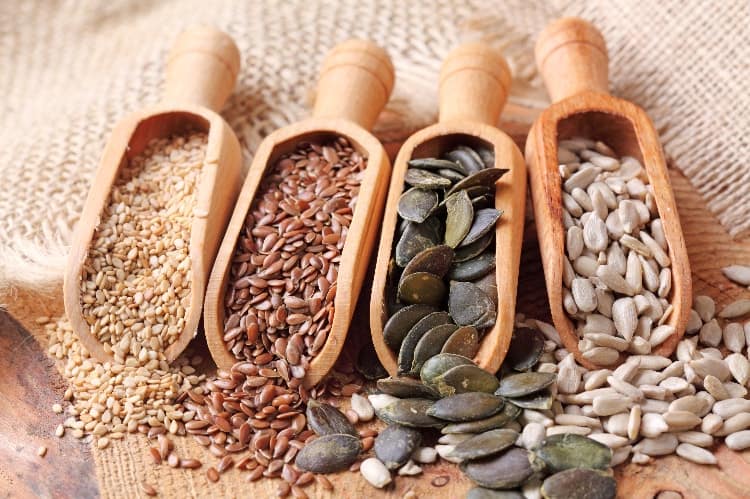
If you’re looking for a food-based protocol that is designed to support the female body at any age, then look no further than the practice of seed cycling for hormone balance.
Also known as seed rotation, this natural approach to hormone health uses specific edible seeds to support our hormones during each phase of the menstrual cycle.
Now, even though seed cycling isn’t taught in mainstream medical schools, it’s taught to alternative practitioners (such as naturopathic doctors) and it may help to support your hormones (along with maintaining a diet and lifestyle that is hormone-friendly).
When used as a part of a hormone-balancing diet, seed cycling may help with irregular periods, fertility issues, acne, menopause, hair loss and more.
So, to help you get started with seed rotation, this post is going to cover:
- the benefits of seed cycling.
- how to seed cycle for hormone balance.
- additional tips for adding seeds to your diet.
WHAT IS SEED CYCLING?
Seed cycling is a food-based approach to hormone balance that involves eating two sets of seeds during each phase of the menstrual cycle.
Now, there are two phases to the menstrual cycle: follicular phase and luteal phase.
When you seed cycle you consume the following seeds:
- Pumpkin and/or flax seeds: follicular phase (approximately days 1 – 14)
- Sesame and/or sunflower seeds: luteal phase (approximately days 15 – 28)
HOW SEED CYCLING WORKS
Now let’s take a look at each phase of the menstrual cycle to understand how each set of seeds supports our hormones.
The Follicular Phase
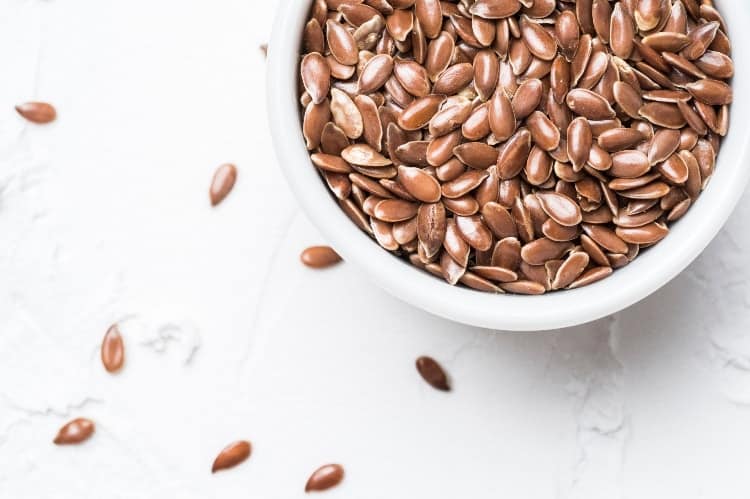
The follicular phase starts on day 1 of your period and ends just before you start ovulating. If you’re on a 28-day cycle, your follicular phase might last about 14 days (so days 1 – 14 of your cycle).
Now, having said that, the duration of the follicular phase varies from one woman to another, and even from one cycle to another. In general, this phase lasts anywhere from 10 to 22 days.
So, just remember that the follicular phase is the first part of your cycle and it ends when ovulation starts 🙂
During the follicular phase, the following changes occur in the body:
- Estrogen levels start out low and then increase as your body prepares to release an egg (and prepares for a possible pregnancy).
- As your estrogen levels change, the levels of luteinizing hormone (LH) and follicle stimulating hormone (FSH), also change.
So, to help support the natural fluctuations that occur during the follicular phase, you’ll be eating flax seeds and/or pumpkin seeds.
Here’s what these seeds do for the body:
- Flax seeds contain lignans, which are natural compounds that help the body get rid of excess estrogen. This helps maintain a healthy ratio of estrogen to progesterone. It also protects your body from going into a state of estrogen dominance.
- Both flax seeds and pumpkin seeds are good sources of zinc (with pumpkin having a lot more zinc per serving). Zinc happens to be essential for supporting progesterone production (which occurs in the next phase of your cycle).
- Studies show that zinc deficiency is linked to PMS. Since pumpkin and flax seeds contain zinc, they can help in improving PMS symptoms.
- Flax seeds and pumpkin seeds are high in omega-3 fatty acids. And omega-3’s are essential fatty acids that regulate FSH levels, reduce inflammation. In addition, omega-3 fatty acids are essential for the production of sex hormones and adrenal hormones.
- Research also indicates that flax seeds can lengthen the next phase of the cycle (the luteal phase). Ultimately, this reduces PMS symptoms like cramps. In addition, a healthy luteal phase also improves ovulation and supports natural conception.
- For women with PCOS, flaxseeds have been shown to reduce the levels of androgens, which are a major contributing factor in irregular/missing periods, facial hair growth, acne and hair loss.
The Luteal Phase
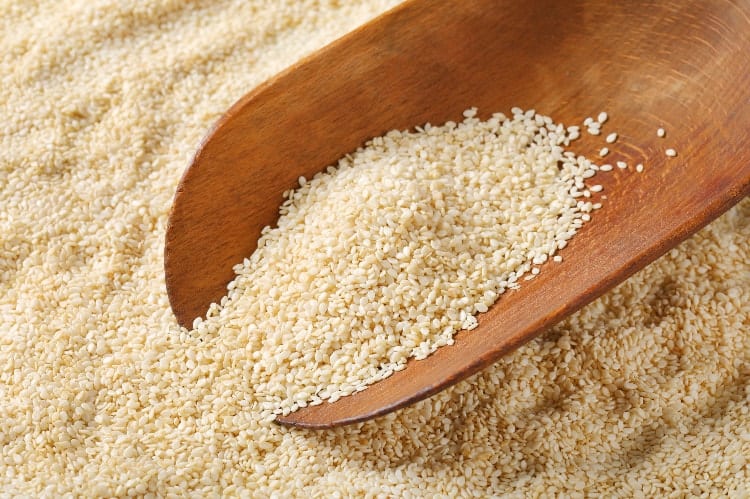
Now we’re on to the luteal phase, which is the second phase of your menstrual cycle.
This phase starts right after you ovulate and ends when your next period starts. If you’re on a 28-day cycle, this phase might last about 14 days (days 15 – 28).
However, it’s not uncommon for the luteal phase to last anywhere from 9 to 16 days.
Here’s a quick overview of what happens during the the luteal phase:
- After ovulation, the follicle that contained the egg collapses back on itself and forms something called a corpeus luteum. This corpeus luteum secretes progesterone and estrogen.
- Progesterone levels usually peak about halfway into this phase. The rising progesterone causes the lining of the uterus (i.e. the endometrium) to thicken in case an embryo is implanted.
- Estrogen levels also fluctuate during this phase. If they get too high, it could lead to PMS symptoms and an uncomfortable cycle.
To support the natural fluctuations that occur during the luteal phase, you’ll be eating sesame and/or sunflowers seeds.
Here are the main benefits of these seeds:
- Sesame seeds contain lignans which bind excess estrogen and eliminate it from the body. This helps to maintain a healthy ratio of estrogen to progesterone.
- Sunflower seeds are loaded with selenium, which is great for the liver. This is a huge benefit since the liver filters out excess hormones and toxins that contribute to hormonal imbalances. So, having a healthy liver is basically an insurance policy for your hormone health!
- Both sesame and sunflower seeds are good sources of omega-6 fatty acids. When consumed, omega-6 is converted into GLA (gamma linoleic acid) in the body, which supports progesterone production and lowers inflammation.
THE BENEFITS OF SEED CYCLING
So, as we’ve seen so far, eating seeds for hormone support can help:
- lower inflammation
- prevent or improve estrogen dominance
- support healthy progesterone levels
- maintain a healthy ratio of estrogen to progesterone
As a result of all this, seed cycling can help improve symptoms and conditions such as:
- PMS
- Amenorrhea (missing period)
- Perimenopause
- Menopause
- Thyroid issues
- Fertility issues
- Endometriosis
- PCOS
- Ovarian cysts
- Irregular periods
- Hormonal Acne
- Hair loss
- Breast tenderness
- Bloating
- Mood swings
- Insomnia
HOW TO DO SEED CYCLING
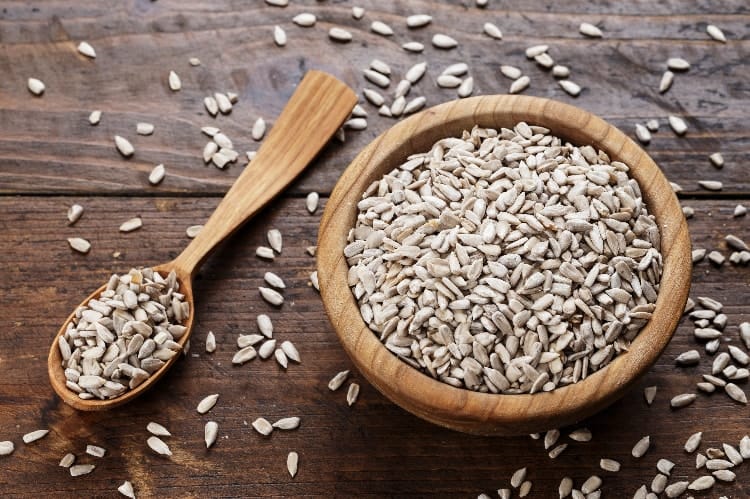
During each phase of your cycle, you will eat two sets of seeds.
Now, here’s the breakdown of how to rotate seeds.
| FOLLICULAR PHASE (DAY 1 – 14) | LUTEAL PHASE (DAY 15 -28) |
| Flaxseeds and/or pumpkin seeds | Sesame seeds and/or sunflower seeds |
| 1 to 2 Tbsp total per day | 1 to 2 Tbsp total per day |
Please note that during each phase, you can eat just one seed if that’s all you have on hand.
So, if you decide to eat only flaxseed during the follicular phase, then eat 1 to 2 Tbsp of it.
However, if you decide to eat flaxseed and pumpkin, then you can do 1/2 Tbsp of each or 1 Tbsp of each.
It’s totally up to you and what your taste buds like.
WHEN SHOULD I START CYCLING WITH SEEDS?
If you have regular cycles, then start the follicular phase seeds on the first day of your period.
On the other hand, if you don’t have a period, either because of menopause or amenorrhea (missing period), then some experts suggest using the new moon as your guide.
This means you should eat:
- follicular phase seeds from the new moon to full moon.
- luteal phase seed from the full moon to new moon.
Not sure when the moon phases happen each month? Just google it 🙂
TIPS ON HOW TO BALANCE YOUR HORMONES NATURALLY WITH SEEDS
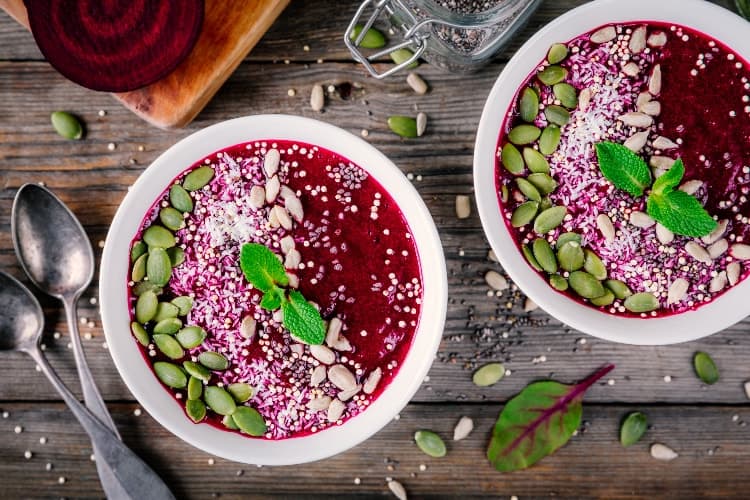
1. Incorporate Seeds Into Your Meals and Snacks
Here are some simple ways in which you can get your daily servings of these hormone-balancing seeds:
- add them to your hormone-friendly smoothies.
- sprinkle onto salads or oatmeal.
- mix them into yogurt.
- sprinkle them onto soups (to avoid overheating the seeds, add them after the soup is done cooking).
In addition, these seeds are very easy to sneak into tasty snacks and desserts.
To see what I mean check out this collection of hormone-balancing energy ball recipes, many of which use these seeds!
2. Raw Seeds Work Best
Make sure to buy raw, unroasted, unsalted, unseasoned nuts.
Cooked seeds don’t have much of the healing components that your body needs.
3. Keep Toxins Low
Since we’re already surrounded by lots of hormone disruptors, it’s best to use organic seeds.
This reduces your exposure to pesticides and herbicides (that are known to mess with our hormones!).
4. Use Freshly Ground Seeds
Always store your whole seeds in the fridge or freezer to maintain freshness.
And for best results, grind the seeds every day.
However, if this isn’t practical for your schedule, then grind a small quantity and store it in the freezer for several days.
5. Have Fun and Mix It Up
You can still eat other nuts and seeds while you are rotating seeds.
So, don’t be afraid to enjoy things like chia seeds, almonds, peanuts and more during this time.
Also, don’t panic if you happen to eat a follicular phase seed (like flax) during your luteal phase (or vice versa).
The goal isn’t to be super strict about this. You simply want to eat more of the seeds that support your body during the appropriate phase.
The healthy fats from these other foods will help to round out your diet and boost hormone health.
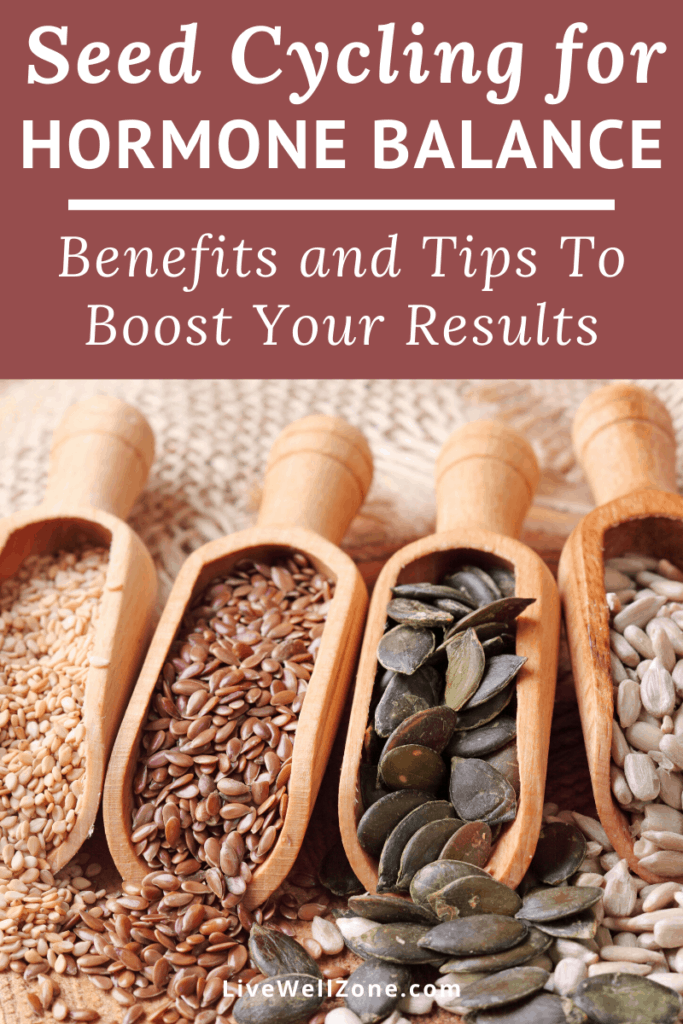
RELATED QUESTIONS
Do the seeds have to be ground?
Yes, grinding the seeds seems to make them easier for your body to absorb so that you can enjoy all of their hormone-balancing properties.
Does flaxseed raise estrogen levels?
Even though flaxseeds contain plant-based estrogen, they do not appear to raise estrogen.
Instead, flaxseeds are able to help your body adjust estrogen levels as needed.
This means that they can raise estrogen when needed and they can also help to eliminate/reduce excess estrogen.
Does seed cycling work for menopause?
Yes, rotating seeds can help to support hormones during menopause.
Simply use the new moon/full moon schedule from above to figure out how to cycle the seeds.
What Seeds Are Good for PCOS?
All the seeds that are part of the seed rotation protocol are beneficial for PCOS.
In addition, you can also add chia seeds and hemp seeds to your PCOS diet.
Both chia and hemp seeds contain omega-3 fatty acids, fiber and various minerals that support hormonal health for anyone with PCOS.
Does Seed Cycling Help With Acne?
Depending on the root cause of acne, seed cycling can help.
Acne can occur because of a slow-functioning liver, estrogen dominance, poor gut health or poor nutrition.
Rotating seeds does support liver health, helps prevent estrogen dominance and also contains healthy fats and nutrients for gut health.
However, to get rid of acne completely, you also need to reduce inflammation.
To get started, check out this guide on how to get rid of hormonal acne.
How Long Does Seed Cycling Take To Work?
This method is basically a dietary change.
And as with all dietary changes, consistency is key for seeing results.
So, stick with it for at least 1 full cycle in order to start seeing results.
Depending on the severity of your symptoms, it may take about 3 cycles before you see noticeable changes.
Do hemp seeds increase estrogen?
No, hemp seeds do not increase estrogen. They don’t contain estrogen nor do they have any estrogenic effects.
Hemps seeds are actually quite helpful for regulating our hormones because they contain healthy fats that the body uses for hormone production.
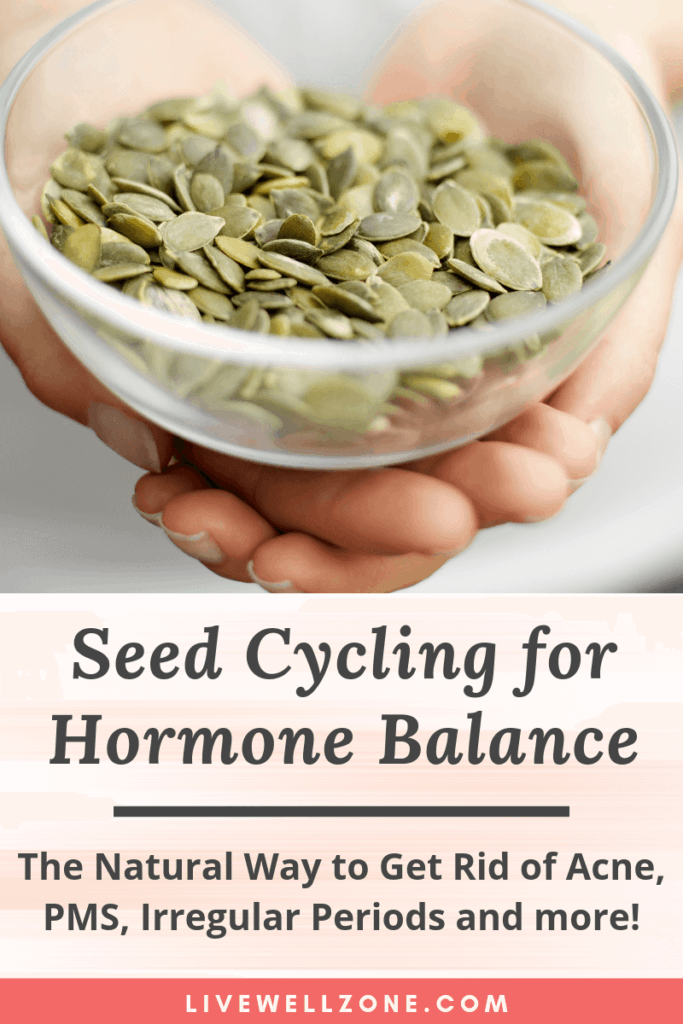

CONCLUSION
Using food as medicine, or in this case, seeds as medicine, can help you improve a significant number of health issues.
But remember that seed cycling isn’t meant to be a magic wand.
It’s still important that you follow a diet that supports hormone health. If you need help figuring out what that type of diet looks like, then use this guide on how to put together a hormone-balancing diet plan.
Oh, and when it comes to these seeds, please don’t freak out if you miss a day here or there 🙂
Just get into the habit of having them in your kitchen and you will eventually eat them more and more.
Now, over to you: what’s your biggest takeaway from this article and are you already balancing your hormones with seed rotation?
Drop a comment below!
Related Posts:
Hormone-Balancing Smoothies for PMS: Recipes and How To Use
Essential Oils For Your Period – 10 Best Oils For Cramps, Acne and More!
5 Essential Oils for Heavy Periods That Provide Real Relief
10 Herbs for Heavy Menstrual Bleeding (That You Need To Know!)
How To Make The Best Smoothie for Period Cramps (That Actually Works!)


Great post! Thank you for explaining that flaxseeds raise estrogen only when needed and eliminate it when it’s not needed. I wanted to add flaxseeds to my diet but was afraid to after hearing that doing so would raise my estrogen levels. Thank you for clearing that up!
Thanks 🙂 The idea that food is actually “smart” gets left out of a lot of conversations. It can be hard to filter through the noise, but it sounds you figured what to tune out (and what to listen) for your well-being!
Wow! Did is great , so happy dat I come across dis
I have been doing this for one month so far and I have already seen major improvements! Way less PMS, no more hot flashes, less cramps and better moods! What is the best way to eat the seeds? Do you have any recipes for it?
That’s awesome! You can use them in salads, oatmeal or pudding. I like using flax and sunflower in all 3 of those. Smoothies are also a great way to include them in your diet. Here are some hormone balance smoothie recipes you can try.
Thanks! I hadn’t thought about putting them in oatmeal!
I’ve lived with pcos for years. For a majority of the time it was an obscure diagnosis that few talked or knew about. Doctors just want to throw pills at problems these days. So glad to find this article. I have recently switched to a whole food plant based diet that incorporates lots of seeds and nuts. Good to know to rotate them out for more reasons than variety.
Glad you’re finding a solution that works for you!
If any one tried and achieved good results by following “Seed cycling” it will cure 100% PCOD problem ?
It’s just one of the things to include in your diet. If the rest of your diet isn’t very healthy then seed cycling alone is unlikely to change much.